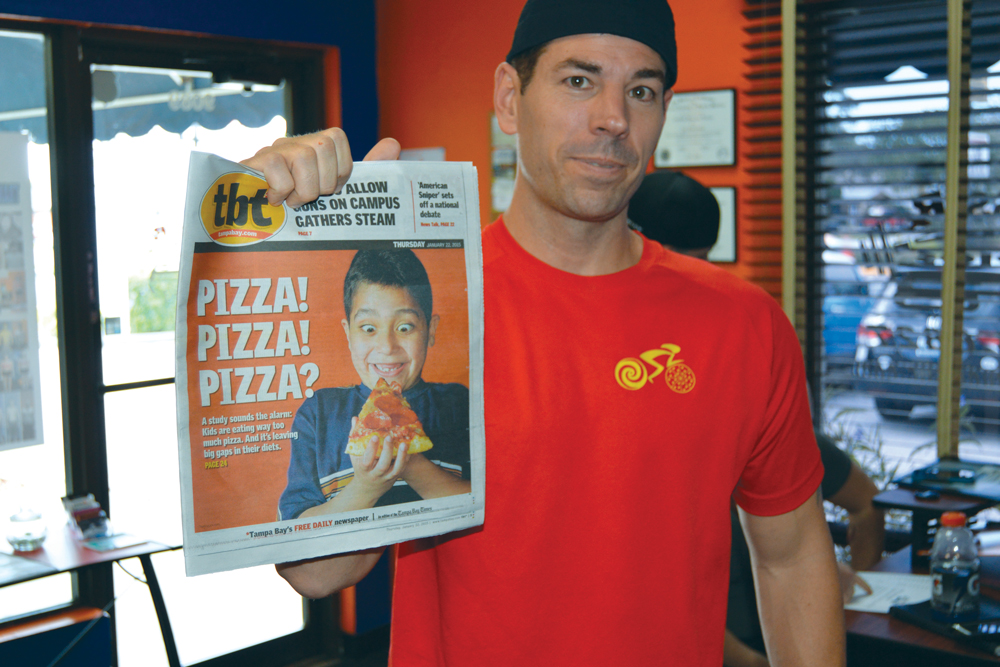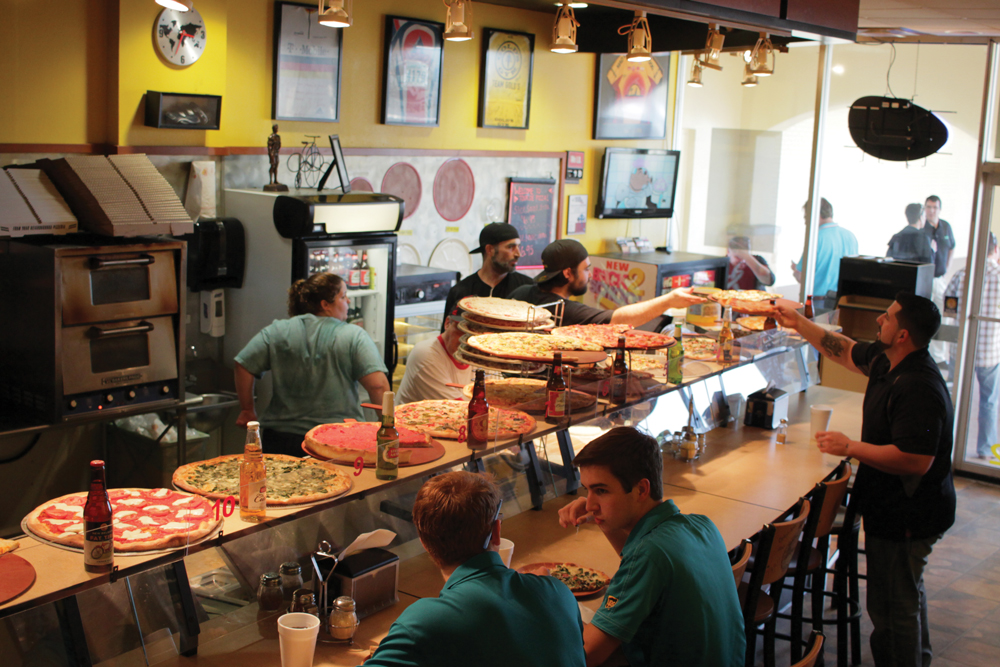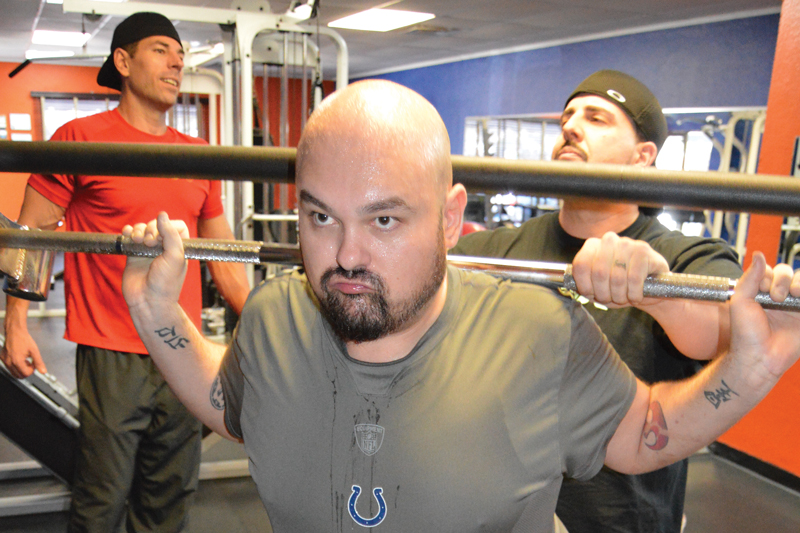America’s favorite food seems to be perennially under attack. But despite dire warnings from health advocates and news media scaremongers who blame pizza for obesity in children, many nutrition experts say pizza is not only delicious; it can also be a healthy food choice.
Nutritional studies that trashed pizzerias for heaping on the salt were widely promoted in late 2014, but the blockbuster assault came with a study published in Pediatrics, the journal of the American Academy of Pediatrics, in January 2015. In that report, researchers blamed pizza for boosting calories, saturated fat and sodium in the diets of American children and adolescents. News outlets around the country, including ABC’s Good Morning America and The New York Times, touted the study, but it was a recent report in the Tampa Bay Times that got Matt McClellan’s attention. Now McClellan, owner of two Tour De Pizza (tourdepizza.com) stores in St. Petersburg, Florida, and the inventor of the 30-Day Pizza Diet, is ready to go to war on behalf of pizzerias and the food he loves to eat every day.
“Our industry is taking a beating from thousands of doctors and so-called nutrition experts who are attacking pizza to make a profit,” McClellan says. “These biased advocates for public health don’t even eat healthily themselves, but they’re taking money out of our pockets. I want to be a voice to stop the assault on pizza.”
Living Proof
McClellan has lent more than his voice to the counterattack against the “nutritionally correct” media and food policy gang. He has donated his body to the cause. After moving from Denver to open a pizzeria on Florida’s Gulf Coast, McClellan invented his pizza diet in 2009. He was a new pizzeria owner at the time, pitching the local gym on free pizza samples to encourage business. When the workout crowd and a reporter with the local paper challenged him to prove that pizza could be healthy, the determined entrepreneur put his pizza where his mouth is and agreed to eat nothing but pizza for 30 days.
The results were startling. Eating a slice of pizza every 2½ to 3 hours, McClellan lost 25 pounds in 30 days. Perhaps more remarkably, he lowered his cholesterol 86 points and his body fat by 10% with no medications. “There is no secret to this diet,” McClellan says, with the confidence of a man who has opened multiple successful businesses and won Best Physique contests. “It’s good nutritional science based on portion control, raising metabolism levels with the help of a regular workout plan, and tracking daily intake of carbohydrates, protein, fiber and fat.”
McClellan wanted to prove a simple point: You can lose weight and stay healthy eating only pizza. “Not just pizza, but the kind of good, old New York-style pizza I make in my pizzeria with standard ingredients that are in pizzerias around the country,” McClellan adds.
He went on to refine his pizza diet and eventually started entering—and winning—bodybuilding competitions. He enlisted Jay Sherinsky, owner of Fitness RX Studios in St. Petersburg and a personal trainer and diet consultant, to help him design a fitness regimen. “No food of itself is good or bad,” Sherinsky notes. “Pizza is my favorite food. I eat a lot of it, but my research helping thousands of clients shape their bodies and improve their health tells me that a balanced intake of macronutrients—carbs, fats, proteins and fiber—combined with regular exercise is the key to weight control and an optimally performing body.”
Another member of McClellan’s pro-pizza posse, Kelly Murphy, a Tampa, Florida-based certified personal trainer and author, works with women as a lifestyle coach, helping them overcome their worst phobias. She says she counsels her clients not to obsess about enjoying their favorite indulgences, such as pizza. “Fear is the biggest obstacle in our mental and physical health,” Murphy says. She decided to team up with McClellan to help preach his “pizza power” message after reading his story in a fitness magazine.
“I share Matt’s passion for doing what you love and eating what you love,” Murphy says, munching on a slice of thin-crust Margherita pie outside of McClellan’s Tour De Pizza. “Women don’t like to be deprived—of the foods they love and the experiences they value. I help them lose weight, partly by teaching them to overcome their obsessive fear about giving in to indulgences. I tell them there is no need to deprive yourself of fast food. I advise them to follow the ‘calories in, calories out’ system. If you eat a slice of pizza, keep moving. Delicious food, like this fabulous slice I’m eating, is part of the diversity of life. I fully support Matt’s initiatives for making the case on a national level that pizza is a healthy food option.”
 |
|
Matt McClellan, owner of Tour De Pizza in St. Petersburg, Florida, and an advocate for the nutritional value of pizza, displays a recent newspaper headline that portrays America’s favorite food in a negative light. |
Pizza Pushback
But researchers like Lisa Powell, a University of Chicago professor of health policy and lead author of the Pediatrics study on kids and pizza consumption, have made a different argument to the national news media. “Parents should aim to curb pizza consumption, particularly as a snack, where it was shown to have the largest adverse impact on children’s calorie intake, and they should put their pizza dollars toward healthier brands,” Powell told LiveScience.com in February.
Powell’s study, which analyzed 24-hour dietary practices of more than 12,000 children over a seven-year period, found that youngsters between the ages of 2 and 11 consumed an extra 84 calories on the days they ate pizza, while adolescents consumed an extra 230 calories. The study also blamed pizza for increasing the subjects’ saturated fat and sodium intake.
But here’s another takeaway from the study that received less publicity: During the period that the research—collected from questionnaires tallied every two years between 2003 and 2010—was conducted, Powell’s team found that the number of calories children consumed from pizza actually decreased by 25%. The study’s adolescent population (ages 12 to 19) decreased its caloric intake from pizza by 22%.
Even the staunchest pizza advocates agree that eating too many meat-laden pies, chased down with multiple beers or sugar-packed soda, is a recipe for weight gain. But the ancient food source—cheese and antioxidant-rich tomatoes on bread—that fueled the Roman legions has also inspired research that partially contradicts the pizza critics. Several recent studies have found evidence that pizza, when judiciously prepared, offers lifesaving benefits. A 2013 article in Public Health Nutrition stated, “Key pizza ingredients have been associated with improved cardiovascular health and cancer prevention.” In that study, a team of Scottish scientists from Glasgow University and Glasgow Caledonian University developed a range of new recipes to create “nutritionally balanced pizza” made with whole-wheat flour, less salt and a little Scottish seaweed to boost flavor and vitamin content.
Another 2013 study, led by Dr. Silvano Gallus of the Mario Negri Institute for Pharmaceutical Research in Milan, touted habitual pizza consumption as a “favorable indicator” for preventing heart attacks and reducing the risk for esophageal, colon and mouth cancers. “We knew that tomato sauce could offer protection against certain tumors, but we did not expect pizza as a complete meal also to offer such protective powers,” Gallus told the BBC.
Best of Both Worlds
Julie Ghazi, founder of Pure Pizza (purepizzaclt.com) in Charlotte, North Carolina, has staked her future on the proposition that the nation’s favorite comfort food can be both delicious and healthy. “Pizza isn’t ever going away, but it can be made healthier,” says Ghazi, who left her job with an architectural firm in 2012 to found a business she thought might be recession-proof. “When we started Pure Pizza, we were determined to get ahead of the wave of nutritional awareness that is shaping consumer food choices. That wave has become a tsunami, which is crashing right now, thanks to FDA-mandated menu labeling and a national demand for food that is more organically sourced and sustainable.”
Pure Pizza answers that demand with “farm-to-fork” ingredient sourcing and organically grown tomatoes, among other sustainable strategies. But the foundation of all pizza is the crust, the chief source of its calories and the heart of its crunchy popularity. Ghazi considers Pure Pizza’s whole-grain dough, developed by head chef and dough pioneer Peter Reinhart, to be the company’s signature contribution to a healthy pizza evolution. Reinhart makes the pizza crust from sprouted ancient grains, such as amaranth, buckwheat and whole wheat. “Sprouting the grains before they are dried and milled produces high-quality dough that retains the sweetness of traditional white flour dough without any need to add sugars,” Ghazi notes. “We believe this approach reflects the next frontier in baking.”
Other pizza chains, particularly within the fast-casual segment, are also moving toward healthier ingredients. Naked Pizza (nakedpizza.biz), with stores in Louisiana, New Jersey, Virginia, Washington and the United Arab Emirates, promotes its use of “all-natural” meats—antibiotic- and hormone-free toppings—along with its ancestral-blended 10-grain dough. Fast-casual leader Uncle Maddio’s (unclemaddios.com) also touts its organic and hormone-free meat toppings, as does the three-location Skinny Pizza (skinnypizza.com) in New York.
 |
|
The interior of Tour De Pizza is a veritable shrine to health and fitness, with walls covered in functional bikes, frames filled with articles touting pizza’s inherent healthiness, and showcases of Matt’s escapades as a pizza diet spokesperson. |
The Pizza Experience
So the question remains: Does pizza, in its standard cheesy, crusty, saucy, meat-packed form, pose a deadly threat to America’s health and waistlines?
Not necessarily, says Diane Zych, the top registered dietitian with BJC Healthcare in St. Louis, a leading academic healthcare organization affiliated with Washington University School of Medicine. “Everyone—including me—loves pizza,” Zych says. “I would much rather eat a slice of pizza, from a nutritional standpoint, than a fast-food hamburger. Eating is not just about nutrition—it’s about an experience. Traditional foods like pizza give us joy. These are special foods that unite us as families. It gives us satisfaction and the good vibes of a shared meal.”
Zych adds that pizza—especially the kind you purchase at an independent pizzeria offering specialty choices with a focus on vegetables and lean protein—can be a conscientious food choice for the whole family. “It’s completely possible to enjoy pizza and be calorie-conscious,” she says. “It’s not hard to make pizza part of a reasonable and balanced meal. A couple of slices of pizza with a salad or some fruit and a nonsugary drink offer a nutritious option.”
It all comes down to portion control and personal responsibility, Zych believes. “If the consumer is trying to reduce calories, I recommend a thinner crust and adding vegetables,” she says. “It’s also a good idea that pizza is not the only food served.”
Teaching children about nutrition, Zych continues, is the parents’ job. “Parents are in charge of what their kids eat,” she says. “Depending on age appropriateness, children can wash and chop the ingredients for your pizza. Vegetables, like spinach, broccoli and cauliflower, can add color and texture as well as flavor and nutrition to your pizza. Stronger-tasting cheeses like feta and goat’s cheese are great because you can use less and add robust flavor. For traditionalists, olives are a healthy ingredient, and so are mushrooms, onions and peppers. Lean meat like chicken can offer a good source of pizza protein.”
Better nutrition and a healthier diet starts at the family table, Zych advises. “To have long-term impact on calorie consumption, we simply need to eat slower,” she says. “Savor that slice of pizza. Pay attention to what you’re eating and enjoy every bite.”
Zych believes pizza can also be an ideal special-occasion meal choice. “Instead of ordering out several times a week from chains, I’d recommend patronizing mom-and-pop pizza restaurants, where you’re more likely to get unique choices with healthier toppings and crust.”
The great pizza nutrition debate is sure to continue, but there’s no disputing that America’s love affair with the time-tested combination of dough, sauce and cheesy desire burns stronger than ever. Pizza, to put it plainly, is good for you.

Building a Better Body With Pizza |
| Brian Hernandez, PMQ’s test chef, is on a mission to build a better body with pizza. After years of struggling with his weight, he met with Matt McClellan, owner of Tour De Pizza in Tampa, Florida, and inventor of the 30-Day Pizza Diet, and started on an extended 120-day version of the diet—along with a tough workout regimen—in late January. He also started blogging about the experience at PMQ.com. “I wanted to help undo the negative press that pizza gets these days,” Hernandez says. “Also, being accountable to the entire nation is a great motivator.”
As of press time in early April, Hernandez had lost 22 pounds and 3.25” on his navel measurement eating mostly pizza for every meal. “It’s been easier than expected,” he says. “I thought I’d get tired of pizza quicker, but if you vary the menu up, it stays fresh and new. Also, with the amount of water I have to drink, I’m more full more of the time.” Hernandez isn’t aiming for fast results—slow and steady wins the weight loss. “I’m a big guy and will always be a big guy, but I can feel comfortable in my own skin at 240 to 250 pounds. I definitely feel I’m on track to get there. I’ll put it this way: I’ll stay on track until I hit 245, then watch out, McDonald’s—I’m ordering 15 Big Macs!” (He’s kidding, of course. We think.) Follow Brian’s progress on his blog at brianspizzadiet.pmq.com. |













